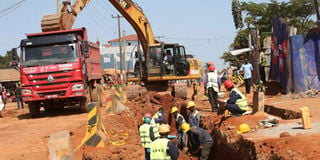KCCA seeks Shs700b for drainage master plan

KCCA workers excavating for pre-installation of drainage systems along Bakuli—Nakulaby road in June 2017. COURTESY PHOTO
What you need to know:
Dumped. The 2017 survey by KCCA also pointed out that 39 per cent of the dumped material in the drainages are by human refuse, 28 per cent of it is of liquid waste, 24 per cent is for kaveera and 5 per cent are plastic materials.
Kampala. Authorities at Kampala Capital City Authority have asked for $208m (about Shs774b) to implement the 2017 Kampala drainage master plan.
Presenting the details of the master plan at the stakeholders meeting in Kampala yesterday, KCCA deputy director engineering and technical services James Ssemuwemba indicated that Shs613b will cater for the capital costs while Shs161b will be channelled to land compensation for the people where the drainage works will pass across the city.
At least 10 flood-prone areas around the central business district have been prioritised to benefit from the multi-billion project.
These include Lubigi, Nakivubo, Kinawataka, Kansanga, Nalukolongo, Ggaba, Nalubaga, Walufumbe, Mayanja/Kalidubbi and Mayanja North.
According to the KCCA drainage master plan, the areas of priority were selected basing on population affected by flooding, impact on residents, commercial and industrial activities, impact on environment, traffic disruption and area of the basin that falls inside KCCA administrative boundaries.
The master plan also cites poor design and construction of drains, clogging and blockages of channels, poor inter connectivity of drains, limited sensitisation of the public, unplanned settlements and poor enforcement mechanisms and attitudes/mindset of the people as some of the issues that are affecting the drainage system of Kampala.
Report on drainages
“We want to handle some of these issues, we might not manage all but shall take one at a time. We are looking at places, which are badly off. That is why we have selected these areas and we shall start with those in the meantime. The population is growing every day and we need to prepare ourselves,” Mr Andrew Kitaka, the acting executive KCCA director, told journalists yesterday.
A report on the development of drainages done by KCCA in 2017 indicated that 79 per cent of the drainages in Kampala were not built, 19 per cent had stone pitch development while only two per cent of them were concrete.
Another socio-economic survey conducted by KCCA in 2017 indicated that the growing population in the city had encouraged dumping, which led to the blockage of most of the channels.
The report showed that 57 per cent of the population were below 40 years of age. Eighty-nine per cent of this population stayed in poorly constructed houses, 50 owned the houses, 48 per cent were renting and 55 per cent had spent less than four years in the area, 11 per cent dump garbage in the drainage.
Mr Erias Lukwago, the Kampala Lord Mayor, said the project will improve the flow of water and prevent flooding within the city. “Some areas are laying in low lands so water settles there and many people are affected by floods. When this project is completed, much as some people cause the floods themselves through dumping, there will be a high level of control through this initiative,” Mr Lukwago said.



